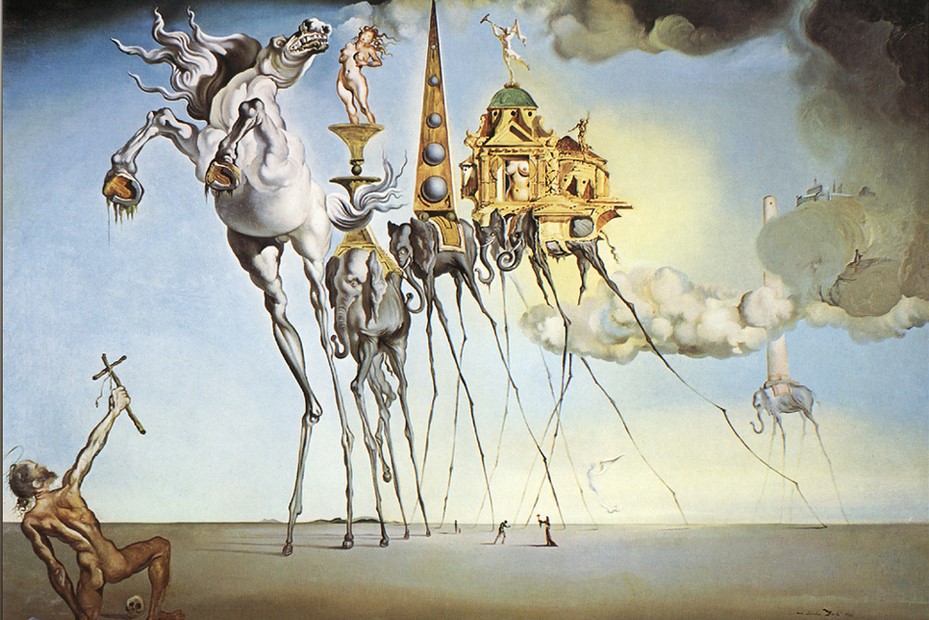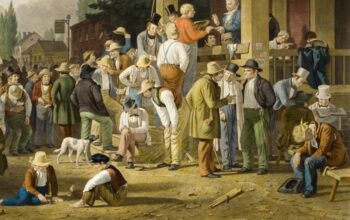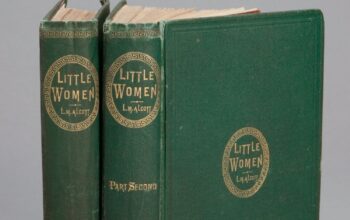Some Notes on Salvador Dalí
How do we evaluate art in the context of morality? This essay by George Orwell examines the life of Salvador Dalí to illustrate some principles of our duty to be responsible, discriminating judges of both ethics and aesthetics.

Autobiography is only to be trusted when it reveals something disgraceful. A man who gives a good account of himself is probably lying, since any life when viewed from the inside is simply a series of defeats. However, even the most flagrantly dishonest book (Frank Harris’s autobiographical writings are an example) can without intending it give a true picture of its author. Dali’s recently published Life comes under this heading. Some of the incidents in it are flatly incredible, others have been rearranged and romanticised, and not merely the humiliation but the persistent ordinariness of everyday life has been cut out. Dali is even by his own diagnosis narcissistic, and his autobiography is simply a strip-tease act conducted in pink limelight. But as a record of fantasy, of the perversion of instinct that has been made possible by the machine age, it has great value.
Here, then, are some of the episodes in Dali’s life, from his earliest years onward. Which of them are true and which are imaginary hardly matters: the point is that this is the kind of thing that Dali would have liked to do.
When he is six years old there is some excitement over the appearance of Halley’s comet:
Suddenly one of my father’s office clerks appeared in the drawing-room doorway and announced that the comet could be seen from the terrace… While crossing the hall I caught sight of my little three-year-old sister crawling unobtrusively through a doorway. I stopped, hesitated a second, then gave her a terrible kick in the head as though it had been a ball, and continued running, carried away with a ‘delirious joy’ induced by this savage act. But my father, who was behind me, caught me and led me down into his office, where I remained as a punishment till dinner-time.
A year earlier than this Dali had ‘suddenly, as most of my ideas occur,’ flung another little boy off a suspension bridge. Several other incidents of the same kind are recorded, including (this was when he was twenty-nine years old)– knocking down and trampling on a girl ‘until they had to tear her, bleeding, out of my reach.’
When he is about five he gets hold of a wounded bat which he puts into a tin pail. Next morning he finds that the bat is almost dead and is covered with ants which are devouring it. He puts it in his mouth, ants and all, and bites it almost in half.
When he is an adolescent a girl falls desperately in love with him. He kisses and caresses her so as to excite her as much as possible, but refuses to go further. He resolves to keep this up for five years (he calls it his ‘five-year plan’), enjoying her humiliation and the sense of power it gives him. He frequently tells her that at the end of the five years he will desert her, and when the time comes he does so.
Till well into adult life he keeps up the practice of masturbation, and likes to do this, apparently, in front of a looking-glass. For ordinary purposes he is impotent, it appears, till the age of thirty or so. When he first meets his future wife, Gala, he is greatly tempted to push her off a precipice. He is aware that there is something that she wants him to do to her, and after their first kiss the confession is made:
‘Now tell me what you want me to do with you! But tell me slowly, looking me in the eye, with the crudest, the most ferociously erotic words that can make both of us feel the greatest shame!’
Then Gala, transforming the last glimmer of her expression of pleasure into the hard light of her own tyranny, answered:
‘I want you to kill me!’
He is somewhat disappointed by this demand, since it is merely what he wanted to do already. He contemplates throwing her off the bell-tower of the Cathedral of Toledo, but refrains from doing so.
During the Spanish Civil War he astutely avoids taking sides, and makes a trip to Italy. He feels himself more and more drawn towards the aristocracy, frequents smart Salons, finds himself wealthy patrons, and is photographed with the plump Vicomte de Noailles, whom he describes as his ‘Maecenas.’ When the European War approaches he has one preoccupation only: how to find a place which has good cookery and from which he can make a quick bolt if danger comes too near. He fixes on Bordeaux, and duly flees to Spain during the Battle of France. He stays in Spain long enough to pick up a few anti-red atrocity stories, then makes for America. The story ends in a blaze of respectability. Dali, at thirty-seven, has become a devoted husband, is cured of his aberrations, or some of them, and is completely reconciled to the Catholic Church. He is also, one gathers, making a good deal of money.
However, he has by no means ceased to take pride in the pictures of his Surrealist period, with titles like ‘The Great Masturbator’, ‘Sodomy of a Skull with a Grand Piano’, etc. There are reproductions of these all the way through the book. Many of Dali’s drawings are simply representational and have a characteristic to be noted later. But from his Surrealist paintings and photographs the two things that stand our are sexual perversity and necrophilia. Sexual objects and symbols–some of them well known, like our old friend the high-heeled slipper, others, like the crutch and the cup of warm milk, patented by Dali himself–recur over and over again, and there is a fairly well-marked excretory motif as well. In his painting, Le Jeu Lugubre, he says, ‘the drawers bespattered with excrement were painted with such minute and realistic complacency that the whole little Surrealist group was anguished by the question: Is he coprophagic or not?’ Dali adds firmly that he is Not, and that he regards this aberration as ‘repulsive’, but it seems to be only at that point that his interest in excrement stops. Even when he recounts the experience of watching a woman urinate standing up, he has to add the detail that she misses her aim and dirties her shoes. It is not given to any one person to have all the vices, and Dali also boasts that he is not homosexual, but otherwise he seems to have as good an outfit of perversions as anyone could wish for.
However, his most notable characteristic is his necrophilia. He himself freely admits to this, and claims to have been cured of it. Dead faces, skulls, corpses of animals occur fairly frequently in his pictures, and the ants which devoured the dying bat make countless reappearances. One photograph shows an exhumed corpse, far gone in decomposition. Another shows the dead donkeys putrefying on top of grand pianos which formed part of the Surrealist film, Le Chien Andalou. Dali still looks back on these donkeys with great enthusiasm.
And finally there is the picture–apparently some kind of faked photograph–of ‘Mannequin Rotting in a Taxicab.’ Over the already somewhat bloated face and breast of the apparently dead girl, huge snails were crawling. In the caption below the picture Dali notes that these are Burgundy snails–that is, the edible kind.
Of course, in this long book of 400 quarto pages there is more than I have indicated, but I do not think that I have given an unfair account of his moral atmosphere and mental scenery. It is a book that stinks. If it were possible for a book to give a physical stink off its pages, this one would–a thought that might please Dali, who before wooing his future wife for the first time rubbed himself all over with an ointment made of goat’s dung boiled up in fish glue. But against this has to be set the fact that Dali is a draughtsman of very exceptional gifts. He is also, to judge by the minuteness and the sureness of his drawings, a very hard worker. He is an exhibitionist and a careerist, but he is not a fraud. He has fifty times more talent than most of the people who would denounce his morals and jeer at his paintings. And these two sets of facts, taken together, raise a question which for lack of any basis of agreement seldom gets a real discussion.
The point is that you have here a direct, unmistakable assault on sanity and decency; and even–since some of Dali’s pictures would tend to poison the imagination like a pornographic postcard–on life itself. What Dali has done and what he has imagined is debatable, but in his outlook, his character, the bedrock decency of a human being does not exist. He is as anti-social as a flea. Clearly, such people are undesirable, and a society in which they can flourish has something wrong with it.
Now, if you showed this book, with its illustrations, to Lord Elton, to Mr. Alfred Noyes, to The Times leader writers who exult over the ‘eclipse of the highbrow’–in fact, to any ‘sensible’ art-hating English person–it is easy to imagine what kind of response you would get. They would flatly refuse to see any merit in Dali whatever. Such people are not only unable to admit that what is morally degraded can be aesthetically right, but their real demand of every artist is that he shall pat them on the back and tell them that thought is unnecessary. And they can be especially dangerous at a time like the present, when the Ministry of Information and the British Council put power into their hands. For their impulse is not only to crush every new talent as it appears, but to castrate the past as well. Witness the renewed highbrow-baiting that is now going on in this country and America, with its outcry not only against Joyce, Proust and Lawrence, but even against T. S. Eliot.
But if you talk to the kind of person who can see Dali’s merits, the response that you get is not as a rule very much better. If you say that Dali, though a brilliant draughtsman, is a dirty little scoundrel, you are looked upon as a savage. If you say that you don’t like rotting corpses, and that people who do like rotting corpses are mentally diseased, it is assumed that you lack the aesthetic sense, since ’Mannequin Rotting in a Taxicab’ is a good composition. And between these two fallacies there is no middle position, but we seldom hear much about it. On the one side Kulturbolschevismus: on the other (though the phrase itself is out of fashion) ‘Art for Art’s sake.’ Obscenity is a very difficult question to discuss honestly. People are too frightened either of seeming to be shocked or of seeming not to be shocked to be able to define the relationship between art and morals.
It will be seen that what the defenders of Dali are claiming is a kind of Benefit Of Clergy. The artist is to be exempt from the moral laws that are binding on ordinary people. Just pronounce the magic word ’Art’, and everything is O.K.: kicking little girls in the head is O.K.; even a film like L’Age d’Or is O.K. It is also O.K. that Dali should batten on France for years and then scuttle off like a rat as soon as France is in danger. So long as you can paint well enough to pass the test, all shall be forgiven you.
One can see how false this is if one extends it to cover ordinary crime. In an age like our own, when the artist is an altogether exceptional person, he must be allowed a certain amount of irresponsibility, just as a pregnant woman is. Dali mentions L’Age d’Or and adds that its first public showing was broken up by hooligans, but he does not say in detail what it was about. According to Henry Miller’s account of it, it showed among other things some fairly detailed shots of a woman defecating. Still, no one would say that a pregnant woman should be allowed to commit murder, nor would anyone make such a claim for the artist, however gifted. If Shakespeare returned to the earth to-morrow, and if it were found that his favourite recreation was raping little girls in railway carriages, we should not tell him to go ahead with it on the ground that he might write another King Lear. And, after all, the worst crimes are not always the punishable ones. By encouraging necrophilic reveries one probably does quite as much harm as by, say, picking pockets at the races. One ought to be able to hold in one’s head simultaneously the two facts that Dali is a good draughtsman and a disgusting human being. The one does not invalidate or, in a sense, affect the other. The first thing that we demand of a wall is that it shall stand up. If it stands up, it is a good wall, and the question of what purpose it serves is separable from that. And yet even the best wall in the world deserves to be pulled down if it surrounds a concentration camp. In the same way it should be possible to say, ’This is a good book or a good picture, and it ought to be burned by the public hangman.’ Unless one can say that, at least in imagination, one is shirking the implications of the fact that an artist is also a citizen and a human being.
Not, of course, that Dali’s autobiography, or his pictures, ought to be suppressed. Short of the dirty postcards that used to be sold in Mediterranean seaport towns, it is doubtful policy to suppress anything, and Dali’s fantasies probably cast useful light on the decay of capitalist civilisation. But what he clearly needs is diagnosis. The question is not so much what he is as why he is like that. It ought not to be in doubt that his is a diseased intelligence, probably not much altered by his alleged conversion, since genuine penitents, or people who have returned to sanity, do not flaunt their past vices in that complacent way. He is a symptom of the world’s illness. The important thing is not to denounce him as a cad who ought to be horsewhipped, or to defend him as a genius who ought not to be questioned, but to find out why he exhibits that particular set of aberrations.
The answer is probably discoverable in his pictures, and those I myself am not competent to examine. But I can point to one clue which perhaps takes one part of the distance. This is the old-fashioned, over-ornate Edwardian style of drawing to which Dali tends to revert when he is not being Surrealist. Some of Dali’s drawings are reminiscent of Dürer, one (p. 113) seems to show the influence of Beardsley, another (p. 269) seems to borrow something from Blake. But the most persistent strain is the Edwardian one. When I opened the book for the first time and looked at its innumerable marginal illustrations, I was haunted by a resemblance which I could not immediately pin down. I fetched up at the ornamental candlestick at the beginning of Part I (p. 7). What did this remind me of? Finally I tracked it down. It reminded me of a large vulgar, expensively got-up edition of Anatole France (in translation) which must have been published about 1914. That had ornamental chapter headings and tailpieces after this style. Dali’s candlestick displays at one end a curly fish-like creature that looks curiously familiar (it seems to be based on the conventional dolphin), and at the other is the burning candle. This candle, which recurs in one picture after another, is a very old friend. You will find it, with the same picturesque gouts of wax arranged on its sides, in those phoney electric lights done up as candlesticks which are popular in sham-Tudor country hotels. This candle, and the design beneath it, convey at once an intense feeling of sentimentality. As though to counteract this, Dali has spattered a quillful of ink all over the page, but without avail. The same impression keeps popping up on page after page. The sign at the bottom of page 62, for instance, would nearly go into Peter Pan. The figure on page 224, in spite of having her cranium elongated into an immense sausage-like shape, is the witch of the fairy-tale books. The horse on page 234 and the unicorn on page 218 might be illustrations to James Branch Cabell. The rather pansified drawings of youths on pages 97, 100 and elsewhere convey the same impression. Picturesqueness keeps breaking in. Take away the skulls, ants, lobsters, telephones and other paraphernalia, and every now and again you are back in the world of Barrie, Rackham, Dunsany and Where The Rainbow Ends.
Curiously enough, some of the naughty-naughty touches in Dali’s autobiography tie up with the same period. When I read the passage I quoted at the beginning, about the kicking of the little sister’s head, I was aware of another phantom resemblance. What was it? Of course! Ruthless Rhymes For Heartless Homes, by Harry Graham. Such rhymes were very popular round about 1912, and one that ran:
Poor little Willy is crying so sore,
A sad little boy is he,
For he’s broken his little sister’s neck
And he’ll have no jam for tea.
might almost have been founded on Dali’s anecdote. Dali, of course, is aware of his Edwardian leanings, and makes capital out of them, more or less in a spirit of pastiche. He professes an especial affection for the year 1900, and claims that every ornamental object of 1900 is full of mystery, poetry, eroticism, madness, perversity, etc. Pastiche, however, usually implies a real affection for the thing parodied. It seems to be, if not the rule, at any rate distinctly common for an intellectual bent to be accompanied by a non-rational, even childish urge in the same direction. A sculptor, for instance, is interested in planes and curves, but he is also a person who enjoys the physical act of mucking about with clay or stone. An engineer is a person who enjoys the feel of tools, the noise of dynamos and smell of oil. A psychiatrist usually has a leaning toward some sexual aberration himself. Darwin became a biologist partly because he was a country gentleman and fond of animals. It may be therefore, that Dali’s seemingly perverse cult of Edwardian things (for example, his ’discovery’ of the 1900 subway entrances) is merely the symptom of a much deeper, less conscious affection. The innumerable, beautifully executed copies of textbook illustrations, solemnly labelled Le Rossignol, Une Montre and so on, which he scatters all over his margins, may be meant partly as a joke. The little boy in knickerbockers playing with a diabolo on page 103 is a perfect period piece. But perhaps these things are also there because Dali can’t help drawing that kind of thing because it is to that period and that style of drawing that he really belongs.
If so, his aberrations are partly explicable. Perhaps they are a way of assuring himself that he is not commonplace. The two qualities that Dali unquestionably possesses are a gift for drawing and an atrocious egoism. ‘At seven’, he says in the first paragraph of his book, ‘I wanted to be Napoleon. And my ambition has been growing steadily ever since.’ This is worded in a deliberately startling way, but no doubt it is substantially true. Such feelings are common enough. ‘I knew I was a genius’, somebody once said to me, ‘long before I knew what I was going to be a genius about.’ And suppose that you have nothing in you except your egoism and a dexterity that goes no higher than the elbow; suppose that your real gift is for a detailed, academic, representational style of drawing, your real Métier to be an illustrator of scientific textbooks. How then do you become Napoleon?
There is always one escape: Into Wickedness. Always do the thing that will shock and wound people. At five, throw a little boy off a bridge, strike an old doctor across the face with a whip and break his spectacles–or, at any rate, dream about doing such things. Twenty years later, gouge the eyes out of dead donkeys with a pair of scissors. Along those lines you can always feel yourself original. And after all, it pays! It is much less dangerous than crime. Making all allowance for the probable suppressions in Dali’s autobiography, it is clear that he had not had to suffer for his eccentricities as he would have done in an earlier age. He grew up into the corrupt world of the nineteen-twenties, when sophistication was immensely widespread and every European capital swarmed with aristocrats and rentiers who had given up sport and politics and taken to patronising the arts. If you threw dead donkeys at people, they threw money back. A phobia for grasshoppers–which a few decades back would merely have provoked a snigger–was now an interesting ‘complex’ which could be profitably exploited. And when that particular world collapsed before the German Army, America was waiting. You could even top it all up with religious conversion, moving at one hop and without a shadow of repentance from the fashionable Salons of Paris to Abraham’s bosom.
That, perhaps, is the essential outline of Dali’s history. But why his aberrations should be the particular ones they were, and why it should be so easy to ‘sell’ such horrors as rotting corpses to a sophisticated public–those are questions for the psychologist and the sociological critic. Marxist criticism has a short way with such phenomena as Surrealism. They are ‘bourgeois decadence’ (much play is made with the phrases ‘corpse poisons’ and ‘decaying rentier class’), and that is that. But though this probably states a fact, it does not establish a connection. One would still like to know why Dali’s leaning was towards necrophilia (and not, say, homosexuality), and why the rentiers and the aristocrats would buy his pictures instead of hunting and making love like their grandfathers. Mere moral disapproval does not get one any further. But neither ought one to pretend, in the name of ‘detachment’, that such pictures as ‘Mannequin Rotting in a Taxicab’ are morally neutral. They are diseased and disgusting, and any investigation ought to start out from that fact.



